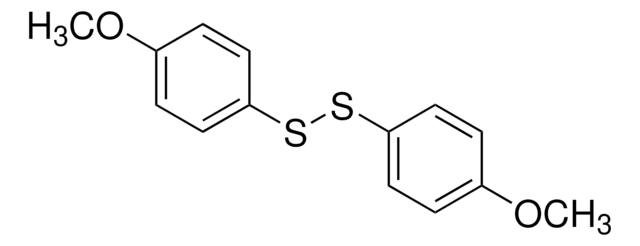N21022
4-Nitrophenyl disulfide
Synonym(s):
p,p′-Dinitrodiphenyl disulfide, Bis(4-nitrophenyl) disulfide, Bis(p-nitrophenyl) disulfide, NSC 4566, NSC 677446
About This Item
Recommended Products
form
powder
SMILES string
[O-][N+](=O)c1ccc(SSc2ccc(cc2)[N+]([O-])=O)cc1
InChI
1S/C12H8N2O4S2/c15-13(16)9-1-5-11(6-2-9)19-20-12-7-3-10(4-8-12)14(17)18/h1-8H
InChI key
KWGZRLZJBLEVFZ-UHFFFAOYSA-N
Related Categories
Application
- Electrophilic cyclization of 2-alkynylanisoles or alkynylanilines
- Oxidative chlorination to sulfonyl chlorides
- Arylation with triarylbismuthanes
- Decarboxylative cross-coupling with dialkoxybenzoic acids
- Disulfidation of alkenes
signalword
Warning
hcodes
Hazard Classifications
Acute Tox. 4 Dermal - Acute Tox. 4 Inhalation - Acute Tox. 4 Oral - Carc. 2
Storage Class
11 - Combustible Solids
wgk_germany
WGK 3
flash_point_f
Not applicable
flash_point_c
Not applicable
ppe
dust mask type N95 (US), Eyeshields, Gloves
Certificates of Analysis (COA)
Search for Certificates of Analysis (COA) by entering the products Lot/Batch Number. Lot and Batch Numbers can be found on a product’s label following the words ‘Lot’ or ‘Batch’.
Already Own This Product?
Find documentation for the products that you have recently purchased in the Document Library.
Customers Also Viewed
Articles
Markovnikov and anti-Markovnikov alkene reactivity differences are discussed, highlighting challenges and catalytic advancements.
Our team of scientists has experience in all areas of research including Life Science, Material Science, Chemical Synthesis, Chromatography, Analytical and many others.
Contact Technical Service
















